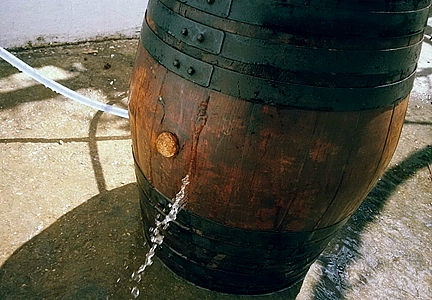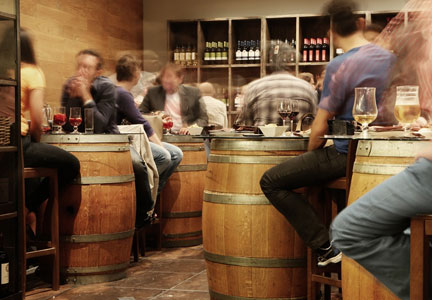The use of wooden barrels during the elaboration process can occur both during alcoholic and malolactic fermentations (second fermentation with the aim of reducing the acidity of the beverage), during the later stages, called thinning, thus initiating the maturation process .
It is precisely in the stage of maturation that the barrels play their most important role. During this stage its use has the power to change characteristics and add elements to the drink, raising its level of quality significantly. Due to its great importance and influence in the sensorial characteristics and the quality of the most diverse types of wine, we clarify some frequent doubts about the use of the barrels.
1. After all, how do the barrels influence the quality of the wine?
When matured in barrels, various compounds and properties present in the wood are transferred to the wine. Thus, characteristics such as scents, textures and structure of the liquid are modified throughout the process in that type of container. Tannins are chemical compounds known as polyphenols, naturally occurring in the grape bark or even in the seed of the fruit. However, several types of wood also have tannins, mainly oak (the most noble wood species widely used in oenology). The tannins are part of the structure of the wood itself and, when they come into contact with the drink, provide more body and density, in addition to influencing their astringency levels, however, the winemaker must be careful to use this raw material, because in Too much can transfer bitterness and mask the fruity aromas of the drink. It is worth emphasizing that tannins add antioxidant properties to wine. We must not forget that the passage of wines by casks interferes substantially with the aromatic characteristics of the product. There are volatile compounds resulting from the degradation of the cellulose, hemicellulose and lignin that form the wood, being released by the process of roasting (burning). It is these substances that are responsible for adding exclusive aromas to the wines, and can include vanilla, clove notes (eugenol), smoked (guaiacol and 4-methyl-guaiacol), sweet aromas (methylfurfural and hydroxymethylfurfural), tobacco, and smoke (monoterpenoids), among many others.
Thus, the process of wine maturation in wooden barrels gives the beverage different levels of complexity, which are often not possible without the use of this resource.
2. How does aging in barrels affect our senses?
To better understand what the sensory gains that wood gives to the drink and why they are interesting, it is important to understand a little about how our perception of taste works. First of all, it is necessary to differentiate two very similar concepts: taste and taste. The taste is directly related to the palate, while the taste involves a much more sophisticated construction, as we will see later. Our language has different types of taste buds, which are activated to a greater or lesser extent whenever they come into contact with a substance present in food or beverages. Each of the papilas is directly associated with one of the five known basic tastes: sweet, bitter, sour, salty and umami (borrowed from Japanese, which can be clearly perceived in the taste of roasted meat or any food that is high in protein.
These five basic flavors unite with the perceptions of temperature, texture and especially aroma to form what we know as flavor. That is why you may like one sweet and not another, because in addition to the basic substrate on which the taste is constituted (the sweet taste), many other sensory stimuli involved in the act of eating or drinking come into play, and can make all the difference in your perception.
Now, if our olfactory system is capable of perceiving about ten thousand different aromas. When we bring all this sensory capacity together into the five basic tastes, we realize the infinite possibilities of flavors that come to us, especially when we consider that different tastes and smells can occur at the same time. Therefore, when we experience a wine of greater complexity, our senses receive a flood of positive information. The richness of aromas and flavors indicates to our brain that this beverage is rich in a profusion of substances and therefore, it is desirable from the biological point of view, because it presents a greater supply of nutrients for the organism.
So if we consider that the stage of the wine in barrels gives a more complex profile and rich in aromatic and gustatory substances, we can understand how our body reacts when we taste the “drink of baco” and because this process is so used.
3. Are the barrels made from only one type of wood?
In most cases, the main wood used for oenological purposes is oak. Up to the present time, a substitute for height, whose aim has been to increase the quality of a wine, has not been found in nature – or even in technological tools. This is because the oak, with its ideal porosity, allows a perfect micro-oxygenation of the wine. This process substantially modifies the texture of the beverage, however, it is worth remembering that oxygen can be the best or worst friend of wine, it all depends on the dose and the moment. Oxygen potentiates chemical reactions in the product causing the wine to become softer and more balanced, but in high amounts it can oxidize and degrade the product.
The use of oak also interferes with the stability of the beverage color. Basically, what gives color to the wines are the anthocyanins (polyphenols) present in the fruit peel. These molecules are extremely delicate and can suffer oxidation and / or precipitation (decanting in the bottle shed), thus the tannins transferred from the barrel to the wine help to maintain the coloration of the wine for longer, as they function as a “buoy” of support for the anthocyanins. Due to the oak barrels present high added value, in many cases, the maturation process can be carried out in stainless steel tanks. The addition of oak splinters to wine is also common practice, especially when talking about low-cost wines, this process is called using alternative oak.
Obviously, the effects achieved with the use of these alternative methods will never be the same as those obtained in the maturation in barrels. But that does not mean that wines that go through these kinds of processes are bad. They are just methods found to reduce costs while offering pleasant wines at affordable prices.
4. Are all oaks used in cooperage the same?
No. There are several types of oak, but only three are widely used for the manufacture of oak barrels: American oak (Quercus alba), pedunculate oak (Quercus pedunculata) and sessile oak (Quercus sessiliflora). European origin. When choosing the type of wood that will make the composition of the barrel, it is necessary that the oenologist takes into account the provenance of the oak, since wood from different regions can print characteristics diametrically opposed to the wine.
Pedunculate oak, for example, is characteristic of the Limousin region of France, and has a high content of polyphenols and low concentrations of aromatic compounds. The sessile, commonly found in the Vosges region, has an exact opposite profile. And the American oak, in turn, has low content of phenols, but high concentration of volatile compounds, especially lactones. Based on these profiles, each producer chooses the wood that most favors their wine. Thus, while many producing regions give preference to French oak, in the United States and Spain the most common is that producers opt for American oak.
5. All the wine must, necessarily, go through a period of aging in barrels?
Not necessarily. Although the most expensive wines available on the market have the common characteristic of the maturation period in oak barrels, this does not mean that to be considered good, a wine must necessarily go through this process. Fruity and fresh wines, for example, in which the indication suggests that they are consumed still young, the maturation period in oak barrels is not necessary. The same can be said of aromatic whites, some types of rosé that do not normally go through this process.
But attention must be paid! Although the best wines of today go through oak barrels before their arrival in the market, it is always good to keep in mind that a naturally low quality wine will not become a high level drink simply because it has been matured or aged in these containers.
The quality of the grapes, the richness of aromas and other factors is that, combined with the properties of oak, they are mandatory and result in good wines.
6. Does the size of the barrel matter?
As a rule, the smaller the container, the greater the oak’s influence on the drink. This is because, as the contact surface of the wood with the liquid is larger in relation to the volume, also the amount of released compounds increases.
Thus, a barrel with the capacity to store 225 liters of wine adds, on average, 15% more compounds from the wood to the drink when compared to the 300 liter barrels.
7. Can wine barrels be reused?
Yes. However, the older a barrel, the fewer compounds it will transfer to the wine. Although large beverages are usually matured in new barrels, some winemakers prefer not to use them, precisely because of the high impact they generate on the aromas and textures of the final product. Also the barrels with more than three uses are already considered neutral, not transmitting more compounds for the wine, at least not in concentrations that affect the drink in a perceptible way in the short term.
Today we also see the barrels used in the maturation of wine being used by breweries, who wish to give their drink some specific character of a label, impregnated in the wood.
8. So, why would a producer choose to grow his wine in stainless steel barrels?
This question has different answers, all of which are equally valid, and the first is in costs. As we have seen, wine barrels can not be used indefinitely, and their financial value is quite high. If the producer wants to obtain a final product with more affordable prices, the choice for stainless steel casks can help you to produce quality wines at a lower price. Another determining factor for the choice of stainless steel casks is that they are inert, that is, they do not interact with the beverage and do not let the oxygen come into contact with the wine. In this way, it is possible for the winemaker to have a much more precise control over the final product result, which will not have external interventions.















